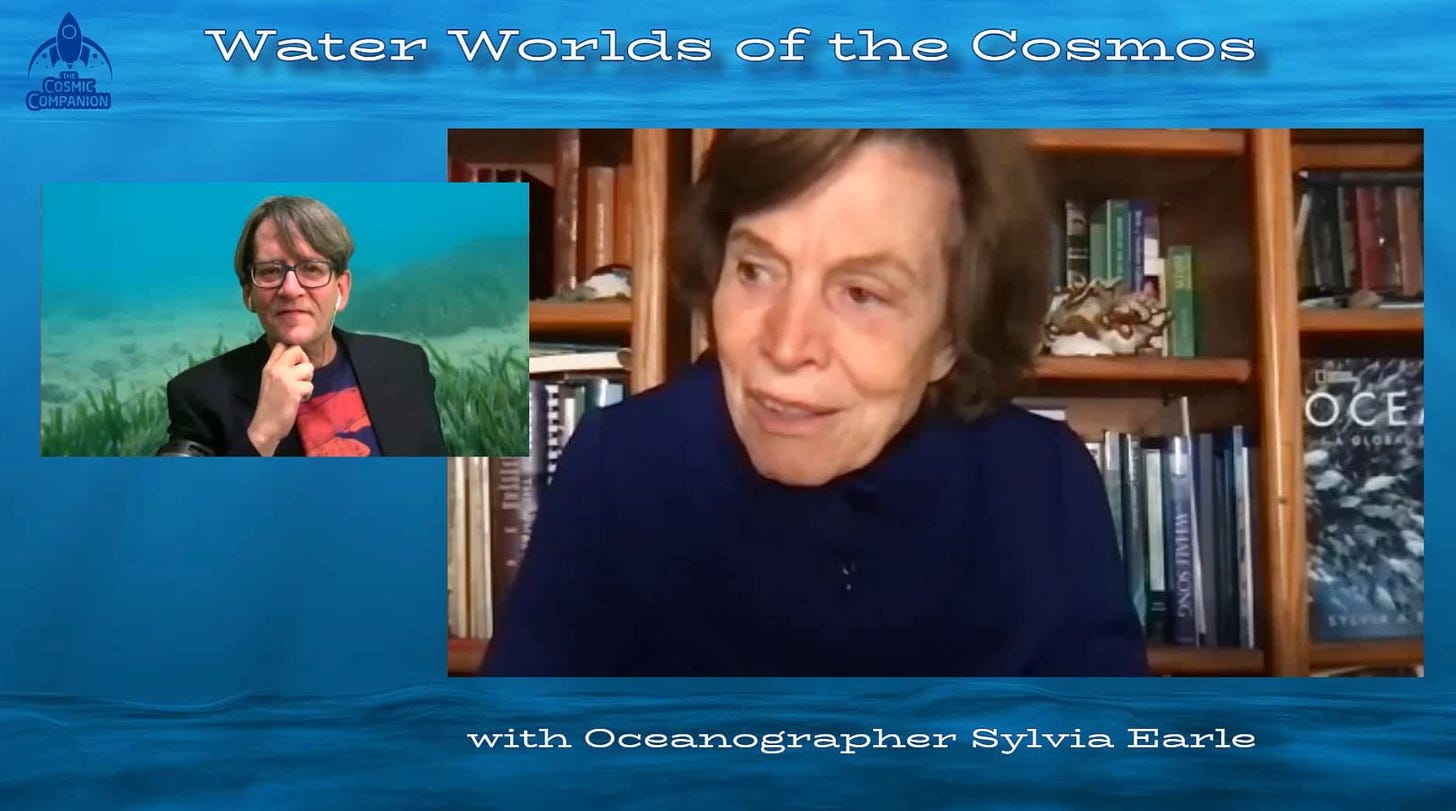Hello everyone!
This week on the Cosmic Companion, we explore the Ocean Worlds of the Cosmos. Later in the show, we will talk with oceanographer and National Geographic explorer Sylvia Earle.
Oceans are one of the defining features of our world, covering roughly three-quarters of the globe. Water is essential to life on Earth, and at one time, we thought this life-sustaining substance was rare throughout the Solar System.
Over the last few decades, researchers have come to understand that water appears to be far more common throughout the Cosmos than ever before believed.
full transcript continues below for VIP subscribers!
Next week on The Cosmic Companion:
Earth’s Neighbor, The Moon
featuring a special in-depth guide to viewing the lunar eclipse happening on 15 May!
Thanks for subscribing!
Clear skies!
James
VIP Extras!
(transcript, cont.)
One of the four large moons of Jupiter, Europa is home to vast oceans, much larger than those on our home world.
Flexing of the crust of Europa caused by the enormous gravitational field of Jupiter creates heating under the frozen surface of this moon. This melts ice, forming subsurface oceans and lakes. The Europa Clipper, the first spacecraft designed solely to explore this intriguing world, is currently scheduled for launch in 2024.
Another of the four great moons of Jupiter, Ganymede, is the largest moon in the Solar System. Astronomers now believe this world could consist of several layers of salt water and ice between its crust and core.
Callisto is the third of these Galilean satellites where oceans as deep as those on Earth could reside. However, the oceans of Callisto are likely hiding beneath 200 km (125 miles) of ice.
But Jupiter isn’t the only gas giant in our solar system which is home to moons covered in water. Saturn, holding onto more moons than even mighty Jupiter, is home to Titan. This mighty moon is thought to possibly hold onto a subsurface ocean saltier than the Dead Sea found between Jordan and Israel.
Oceans might also be found beneath the frigid surface of Saturn’s sixth-largest moon, Enceladus. Jets of water have been seen gushing forth through the 40 km (25 mile) thick layer of ice covering this world. This is thought to be fed by an ocean of liquid water 10 kilometers or six miles deep — as great as that here on Earth.
Remarkably, even some of the largest asteroids may hold onto their own reservoirs of water, notably the asteroid Vesta, orbiting the Sun between Mars and Jupiter.
It is probable that at least some of the water on Earth, as well as elsewhere, arrived from space in the form of collisions for asteroids and comets.
Our own water world holds onto 326 million trillion gallons of this life-sustaining liquid. Just three percent of this is freshwater, suitable for drinking.
Earth is dominated by our global ocean. Today, global climate change, driven by the actions of human beings, threatens life in these oceans in a way never before seen in the history of the human race.
Today, we talk with famed oceanographer and marine biologist Dr. Sylvia Earle discussing what we can learn about water worlds of the Cosmos from the exploration of our oceans here on Earth.
The Europa Clipper is currently reading to journey to the Jovian system, with launch currently scheduled for October 2024. This spacecraft is due to arrive at Europa in April 2030, when it will begin dozens of passes of the moon, searching for terrains where life might exist.
As this satellite of Jupiter— around ninth -tenths as large as our own Moon, orbits its mighty parent, its surface is flexed by the enormous gravitational field of Jupiter, creating heat, and melting ice.
Europa offers us a unique combination of water, chemistry, and energy which might — possibly — be a mixture for the development of lifeforms unlike any seen on Earth.
Even beyond our solar system, astronomers are finding planets rich in water. A Neptune-sized world with the funky name of HAT-P-11b, 120 light years from Earth, is known to hold large amounts of water vapor in a cloudless atmosphere.
Planets too close to their sun see their oceans boil away from heat. Those too far away cannot rely on sunlight to melt ice into liquid water. But those at just the right distance from their parent stars could be home to vast oceans of water.
In our own system, this habitable zone, or Goldilocks zone (where things are neither too hot nor too cold for oceans) extends (roughly) from about the orbit of Venus out to Mars.
Many of the 5,000 exoplanets currently known sit within this zone, and mathematical models suggest water worlds may be common throughout the Milky Way Galaxy.
One pair of these exoplanets are Kepler-62e and f, much older than the Earth, where extraterrestrial life could potentially be billions of years more advanced than our own.
Water vapor has also been seen in Beta Pictoris, an infant solar system, just 20 million years old. Astronomers have recently found 30 comets — dirty snowballs in space — in this young solar system. Water worlds of the future may be forming in Beta Pictoris right now, to be explored by future generations of astronomers.
Join us next week on The Cosmic Companion as we talk about Our Neighbor: The Moon! We have a lunar eclipse happening on the night of 15 May, and we will tell you all about it! Make sure to join us then!
Clear skies!
Thanks again for being a VIP subscriber! Feel free to leave a comment below!
- James




Share this post